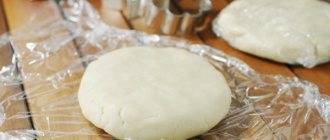How often should a refrigerator be defrosted is a question that ordinary consumers regularly ask. Even if a household refrigeration unit is equipped with a No Frost system, it periodically needs to be turned off and washed. Refrigerators with such a system should be defrosted at least once a year, and simple units should be turned off as frost forms on the walls of the freezer. Also, the frequency of defrosting depends on the intensity of use. So, for example, if the refrigerator is used in production and it is opened several times a day, then it will have to be defrosted more often than usual.
Proper care of the refrigerator ensures long and trouble-free operation of this type of household appliance. However, due to the fact that refrigerators use different freezing systems, the approach to defrosting the equipment differs from each other. The master-na-dom-msk company recommends defrosting in a timely manner to prevent equipment breakdown.
Naledi formation
Periodic defrosting of refrigeration units is carried out to remove ice that has formed on the evaporator housing. The rate at which frost forms in the freezer depends on:
- refrigerator models;
- presence of the “No Frost” system;
- degree of fullness of the freezer;
- frequency of opening and closing the refrigerator door throughout the day;
- lifetime.
The formation of ice is also affected by the temperature of the room in which the refrigeration equipment is installed.
How often should you defrost a refrigerator with a drip ice prevention system?
A refrigerator with a drip ice prevention system (can also be called Frost Free) needs to be defrosted once every 2-3 months.
The drip system involves equipping the refrigerator or freezer compartment with a special “evaporation chamber”. In fact, it looks like a panel to which the refrigerant is separately supplied. It is usually located on the back wall of the refrigerator or freezer.
This panel is cooler than the rest of the interior walls of the compartment. And therefore, excess moisture settles on it, freezing in the form of small droplets. Then the electronics controlling the compressor increases the temperature of the “evaporation chamber”, the ice melts and flows in the form of small droplets into a special tray.
As a result, household appliances essentially defrost themselves. But in the “freezer”, due to constantly low temperatures, moisture condensation and its subsequent removal do not work as well as in the main one. And you have to defrost it manually. This should be done, as mentioned above, once every 2-3 months.
If ice forms more frequently, improper operation of the device may be to blame. Main reasons:
- Loss of seal in the freezer or main compartment. For example, due to damage to the gasket on the door (it is cracked, cut, or fungus has appeared on it). It is worth carefully examining the entire gasket and, if necessary, replacing it;
- Frequently freezing hot foods or liquids in inappropriate conditions. If you want to make ice cubes or, for example, stock up on frozen broth, you should place trays with them on a special shelf;
- Incorrect placement of household appliances. The device requires air exchange, so it is necessary that it stand 5-10 centimeters from the walls (the exact distance is indicated in the instructions). Also, it should not be placed next to a gas stove or other heating elements.
In addition, in refrigerators with a drip system, it is recommended to regularly clean or rinse the defrosted liquid receiver. It is advisable to do this every month.
Defrost frequency
The frequency of defrosting the refrigerator depends on the defrosting system. Equipment with a drip and mixed defrosting system requires periodic manual defrosting for 3-4 months. If there is a No Frost air system, defrosting is carried out automatically, however, manual defrosting is still necessary every six months.
Typically, manufacturers of climate control and freezing equipment indicate in the product data sheet the need and frequency of defrosting the refrigerator. However, if the deadline has not arrived, and there is already a lot of ice, then it is worth defrosting the chamber without waiting for the scheduled date.
Refrigerators without auto defrost
Refrigerators of previous generations do not have a self-defrosting system, so they have to be defrosted manually. The frequency of how often this should be done depends on the manufacturer, the size and age of the unit, and the frequency of opening and closing the door. In any case, you should never wait until ice grows on the wall. In summer, ice forms faster, so you should defrost the refrigerator quite often: every month or once every two months. In winter, this can be done less frequently: once every three months.
Manual defrosting of the refrigerator
A refrigerator repairman in Moscow advises that before defrosting the refrigerator, it must be disconnected from the power supply. After a power outage, all food and removable parts must be removed from the chambers. Since the evaporator has fragile elements, you should not use cutlery when defrosting in order to quickly remove ice from the freezer. It is worth waiting until the ice crust has completely melted and remove the resulting moisture with a dry, clean cloth.
Removable elements are washed with running water and dried well. For sanitization, the inside of the refrigerator is washed with warm water with the addition of baking soda, and then thoroughly wiped with a dry cloth. After defrosting and washing, reinstall all removable parts.
Before loading the refrigerator again with food and plugging it in, you need to leave it with the door open for 1.5-2 hours, reinsert the plug into the outlet and let it idle for a while. After the required temperature has been established in the freezer, you can reload the refrigerator with food.
Defrosting Features
The nuances of the process depend on the defrosting system (No Frost, drip technology), the design of the refrigerator (number of chambers and compressors) and the type of installation of the device (free-standing or built-in).
Built-in
When defrosting a built-in refrigerator, you need to pay special attention to ensure that water does not get on the furniture.
This causes swelling and deterioration of the chipboards from which kitchen units are made.
Penetration of moisture onto metal surfaces leads to corrosion and rust. The rest of the procedure depends on the defrosting system installed in this model.
No Frost System
Devices using this technology provide automatic defrosting of the freezer and refrigerator compartment. The evaporator is located behind the back wall or above the freezer. Air circulation inside the chamber is ensured by an integrated fan. Ice and frost do not appear on the walls, but only on the evaporator. The fan stops periodically to defrost the freezer. The heater turns on, and the melt water flows through the grooves into a special container, where it evaporates from the heat of the compressor.
Still, such refrigerators need to be defrosted at least once every six months. Water accumulating in the lower pan rots and becomes moldy, causing an unpleasant odor in the chamber. To clean and wash the internal surfaces, you need to disconnect the device from the power supply and defrost it. Models labeled No Frost are made by leading manufacturers of electrical appliances: Electrolux, Virpul, Stinol, Samsung, Bosch.
Double chamber
Let's analyze the process using the example of defrosting an Atlant refrigerator with a two-chamber design.
Step-by-step instruction:
- Before defrosting, the Atlant refrigerator is disconnected from the network. Products are removed from the chamber. All removable equipment (containers, boxes, grilles) must also be removed.
- Cleaning the internal surfaces is done with a hard sponge moistened with hot water. Unmelted ice shards are removed manually. The main attention should be paid to the upper chamber. In the lower compartment the ice falls off on its own. To speed up the process, you can lightly tap the camera body.
- When there is no ice and frost left, dry the surfaces using a hairdryer. Hot air is directed evenly onto the inner walls. Hard-to-reach places can be wiped with a cotton napkin.
- The thermostat is set to zero position. The device connects to the network. When the air cools to the required temperature, products are loaded into the chamber.
It is most convenient to defrost two-compressor, two-chamber refrigerators. They are 2 separate closed loop devices combined in one housing. You can turn off only the freezer while leaving the refrigerator compartment running, and vice versa. This solves the problem of food preservation. When defrosting one compartment, supplies are transferred to another. Thus, for example, you can defrost a two-chamber Indesit refrigerator with 2 compressors.
Errors during defrosting
Improper defrosting of the refrigerator can lead to its breakdown. To ensure that the procedure is safe for the device, the following errors must be avoided:
- Sudden temperature changes can damage the device, so in summer it is better to carry out the procedure in the evening or on a cool day. In winter, reduce the heating in the kitchen (if the radiators have a temperature regulator) or pre-ventilate the room.
- It is forbidden to clean the walls of the refrigerator chambers and its shelves from ice with sharp objects - you can pierce the plastic casing, as well as damage the seal or the tube system through which freon circulates. To remove ice crusts, you should use only a special spatula (it is sold included).
- Cleaning with harsh abrasives or chemicals (such as soda, salt or acetic acid) may damage the plastic parts of the device.
- Installing containers with boiling water or very hot water inside the refrigerator to speed up the defrosting process can cause breakdown of the device or damage to the refrigeration chambers.
- Drying or defrosting the refrigerator with a hot hairdryer can destroy the rubber seals.
The design of new refrigerators is very different from older models, and the use of outdated folk advice can harm the device. Before using old grandmother's methods in practice, you should make sure that they are safe.
How to quickly defrost: instructions
Don’t have time to wait until all the ice comes off the walls of the Stinol, Liebherr, Ariston refrigerator? Then use the techniques that helped users of our site quickly cope with the task:
Defrosting with hot water . Boil water, pour it into a metal bowl, and place it in the chamber on a wooden board. Close the compartment door and wait about 20 minutes. Once the water has cooled, refill the bowl with hot water. This will help the ice inside to thaw quickly.
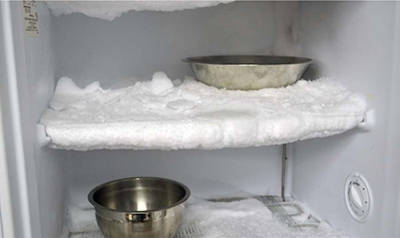
You can speed up the process in the Biryusa, Veko, Saratov, and Electrolux units with a hairdryer. But remember that hot air can melt the plastic on the camera, so try to avoid this method. If you decide, make sure that the air flow is cool or slightly warm. Throw any broken pieces of snow into the sink.
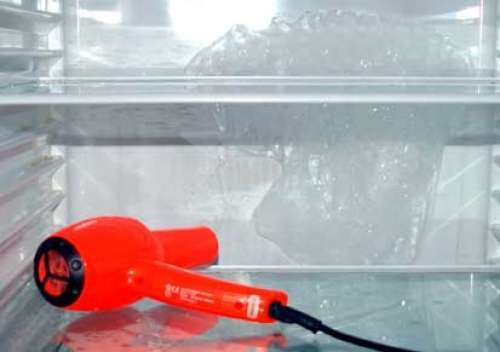
Fan or heater . Dry warm air will help speed up the process. Place the device at the level of the middle shelves and leave for at least an hour until the “clumps” come off the walls.
Attention! Experts strongly advise against using this defrosting method for safety reasons.
Use defrosting liquid or spray . Manufacturers have developed special products for manual ice removal. It is enough to spray the walls, wait for defrost and wipe the walls with clean water.
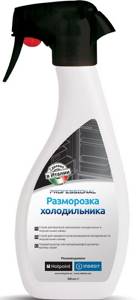
How not to damage equipment
Regardless of the type of refrigerator - built-in or freestanding - defrosting should take place by itself. Do not use physical force or remove ice with foreign objects. This can break through the wall, which will lead to damage to the thermal insulation and breakage, or damage the circuit. Then a refrigerant leak will begin and you won’t be able to do it without a repairman.
Read more about the problem on the page “What to do if the freezer or evaporator is broken.”
Some features of refrigerators with the “no frost” function
Refrigerators equipped with the “no frost” function have an additional cooler-fan installed, which allows cold air to continuously circulate in it. Considering these features of refrigerators, owners are often interested in how often they need to defrost the Nord and other brands of refrigerators and what it depends on.
Remember! Regardless of the type of system operation, the refrigerator must be defrosted and cleaned regularly! The frequency of the process is individual and depends on the functional features of a particular refrigerator model.
What else is useful to know
- After washing the refrigerator, it must be thoroughly dried before turning it on. To speed up the process, you can place a fan in front of the open door, or use a vacuum cleaner that has an air blowing function.
- After drying the refrigerator, you need to wipe the floor under and around it dry so that a short circuit does not occur when turned on. Then wipe the surfaces of the refrigerator with a dry cloth, and only after that can you plug in the appliance.
- You can put food back in after the refrigerator has cooled down sufficiently.
Preparing, shutting down and cleaning the refrigerator
Before starting work, pay attention to the ambient temperature. If the room is too hot and stuffy, it is better to wait for cooler days. The fact is that after switching off, it will be difficult for the compressor to reach the set temperature.
Before removing food, press the defrost button or turn the temperature switch to low. When everything is taken out, check where the water flows. Place containers to collect liquid if the compartment does not have a tray.
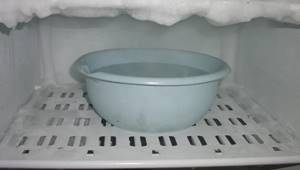
How to preserve food? Food preparations can be taken out to the balcony in winter. In summer, place everything in a saucepan with frozen meat, wrap it in thick paper and cover with a towel.
You can buy special thermal bags in stores. They will preserve your products by the time you turn on the equipment.
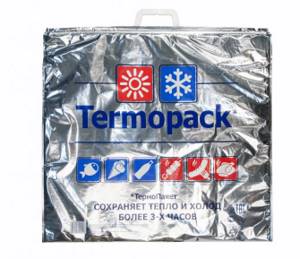
Remove all shelves, grilles, and containers from the compartment. Place a towel under the body. Open the door wide open.
The minimum defrosting time is from three to twelve hours. But it is best to leave the equipment overnight. How long to defrost the equipment depends on the amount of frozen ice and the wear of the system.
Make sure that the two-compartment refrigerator removes moisture from the system properly. If the drainage hole is clogged, clean it with a special brush.
How to defrost an Atlant freezer
Despite the presence of a drip system in the refrigerator compartment, defrosting the Atlant freezer must still be done manually. Cleaning the coldest chamber of the device from excess ice is necessary in the following cases:
- the layer of ice on its walls exceeds 3-5 mm;
- A red light with an exclamation mark is on on the refrigerator control panel - a warning about the increase in temperature inside the device.
The instructions for defrosting the Atlant freezer are similar to the procedure for cleaning a two-chamber refrigerator. When tidying up your freezer, it is important to know that its top shelf is designed for quick freezing of food and is the coldest place of the entire appliance.
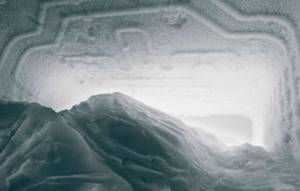
The lower tiers are designed for long-term storage and the temperature is higher. The chamber levels are separated by partitions through which cooling tubes pass. The most ice freezes on them. Therefore, in order to speed up the defrosting process, you should first remove the ice from the partitions.
Instructions for defrosting a two-chamber refrigerator "Atlant"
To avoid damaging the device while cleaning it, you must carefully follow the manufacturer's recommendations. Below are instructions for defrosting a two-chamber Atlant refrigerator; a single-chamber appliance is cleaned of snow and frost according to the same procedure.
Safety requirements
Before defrosting, the Atlant refrigerator must be disconnected from the electrical network, thereby eliminating the possibility of a short circuit and damage to the device due to the ingress of melt water.
Preparation
Before you start defrosting, you need to study the user manual so that you know how to properly disassemble the internal equipment of the cameras and not damage the plastic parts. After this, you should prepare your inventory:
- a basin or other container for temporary storage of contents (you can cover it with an old blanket, it will maintain the temperature inside and slow down the process of heating the food);
- a special spatula for cleaning ice (sold complete with the device);
- wet and dry cloths (preferably microfiber);
- if desired, you can purchase a defrosting spray, which quickly dissolves the ice and reduces the time it takes to tidy up the device;
- refrigerator cleaner or dishwashing liquid;
- rubber gloves to protect the skin of your hands from household chemicals or ice water.
If after washing and drying the refrigerator there remains an unpleasant odor, you can use special products to absorb excess “aromas”, which are sold in household chemicals departments.
Defrosting products
To make the refrigerator defrost faster, you can spray the ice with a product that accelerates the melting of ice. The spray gets the job done in 15-20 minutes. After this, it is necessary to clean the walls of both chambers from any remaining product with a damp cloth or sponge and wipe dry with a towel.
Procedure
Step-by-step instructions for defrosting a two-chamber Atlant refrigerator:
- Set the temperature regulator to minimum.
- Disconnect the device from the network.
- Place a water tray under the drainage hole (some models have a drain hose to pour melt water directly into the sink, without using a tray or basin).
- Remove all food from the chambers and leave the doors open.
- Carefully remove all shelves, drawers and other containers. While defrosting is in progress, wash them with a special refrigerator cleaner or dishwashing liquid and wipe dry.
- When the ice begins to thaw and move away from the inner walls of the device, you can speed up the defrosting process by carefully removing the ice using a plastic spatula. It is sold complete with the device.
- After removing all the ice, clean the inner chamber using a special liquid or mild detergent and wipe with a dry cloth.
- Clean the condensate drain hole with a brush, which is sold in the kit.
- Reinstall the internal parts of the device in their original places.
- Leave the refrigerator open for a while to allow the remaining moisture to evaporate and the smell of detergents to dissipate.
- Set the previous cold mode. Its adjustment, depending on the model, is carried out using a manual rotary control or by pressing keys. In devices equipped with a display that accurately indicates the temperature, it is recommended to set it within 18 degrees. This is enough to maintain food freshness, and energy consumption will be significantly reduced.
- Close the doors and connect the device to the network.
- After about half an hour, you can put the food back in its original place.
- Once the refrigerator is full, you can speed up the cooling process by using the Quick Freeze switch located on the top of the device. When it is turned on, the device begins to freeze faster, but at the same time the duration of the motor operation increases. Therefore, use this function only when absolutely necessary.
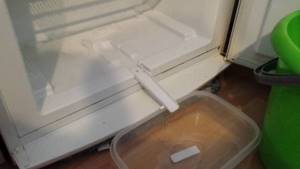
If the refrigerator has two compressors, then you can defrost the chambers separately, transferring all the products from one to another, but in a single-compressor device you can only restore order in both compartments at the same time.









